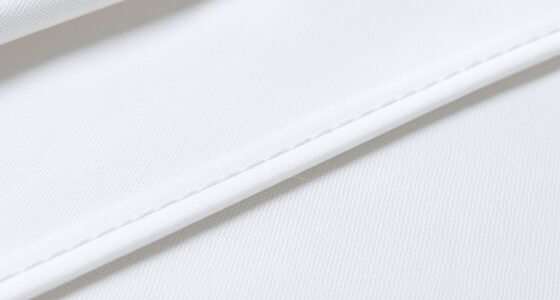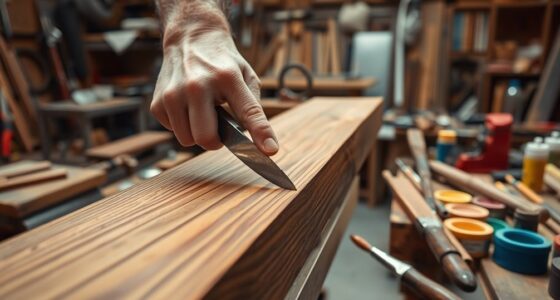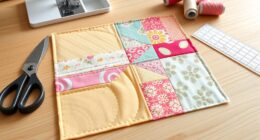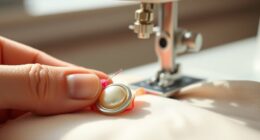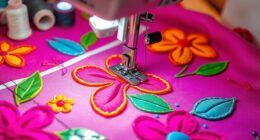To avoid common muslin mistakes, select a fabric that mimics your final material’s weight and stretch, ensuring accurate fitting. Don’t sew blindly; instead, pin, baste, and try on your muslin repeatedly, making small adjustments to address pulling or gaping areas. Focus on pattern modifications rather than assumptions, and use seam allowances thoughtfully. By planning carefully and analyzing each fitting step, you’ll prevent costly errors—if you keep exploring, you’ll discover more tips to perfect your fit.
Key Takeaways
- Select muslin fabric that closely mimics the weight, drape, and stretch of your final fabric for accurate fitting.
- Avoid sewing without pattern adjustments; use muslin to identify and correct pulling, gaping, or fit issues early.
- Use pinning, basting, and multiple try-ons to evaluate fit, making small, incremental modifications each time.
- Clearly mark and note pattern alterations on the muslin to prevent confusion and ensure precise adjustments.
- Invest time in pattern analysis and fitting techniques to minimize errors and reduce costly rework later.

When working with muslin, mistakes are easy to make but equally easy to avoid with the right knowledge. One of the most critical steps is fabric selection. Choosing the right muslin fabric isn’t just about picking a cheap or readily available material; it’s about understanding how the fabric behaves and how that impacts your fitting process. You want a muslin that closely mimics the weight, drape, and stretch of your final fabric, so your fitting adjustments are accurate. Cotton muslin is a popular choice because it’s inexpensive and stable, but if your final garment involves stretch or delicate fabrics, consider a stretch muslin or a slightly lighter weight option to better simulate the final look and feel. Skipping this step or selecting the wrong fabric can lead to fitting issues that are difficult to correct later, wasting time and materials.
Choosing the right muslin fabric is crucial for accurate fitting and avoiding costly mistakes later.
Next, focus on pattern adjustment. When you create your muslin, don’t just sew it together blindly. Pay careful attention to pattern modifications. This is where many beginners falter, assuming that the pattern will fit perfectly without tweaks. Instead, use your muslin to make precise pattern adjustments. For instance, if you notice the muslin pulls or gapes at certain points—like the bust, shoulders, or waist—you need to modify the pattern accordingly. Mark these areas clearly and take notes on what needs changing. Seam allowances are your friends here; use them to let out or take in fabric as needed. Remember, pattern adjustment isn’t a one-size-fits-all solution. It requires you to analyze how each section behaves on your body and make incremental changes. This process saves you from making costly errors in your final fabric, where mistakes are harder and more expensive to fix.
Additionally, when adjusting patterns, don’t rely solely on visual cues. Use fitting techniques such as pinning, basting, and trying on the muslin repeatedly. These steps help you understand how the pattern interacts with your body and reveal issues that might not be immediately obvious. Your goal is to refine the pattern so that it fits smoothly and comfortably, with all darts, seams, and shaping lines sitting correctly. By thoroughly evaluating the muslin and making deliberate pattern adjustments, you ensure that your final garment will have a much better fit, reducing the risk of disappointment or costly rework.
Furthermore, researching pattern fitting techniques can provide valuable insights into achieving perfect adjustments and minimizing common muslin mistakes. In essence, selecting the right fabric and diligently adjusting your pattern are the foundation of avoiding common muslin mistakes. When you approach these steps thoughtfully, you set yourself up for a successful sewing project, saving both time and frustration in the long run.
Frequently Asked Questions
How Can I Tell if My Muslin Fit Is Truly Accurate?
To determine if your muslin fit is accurate, start by checking how well the fabric drapes on your body, ensuring it flows naturally without pulling or sagging. Look at seam consistency—seams should be straight, even, and match up perfectly at junctions. Move around to see if the fit stays comfortable and smooth. If these aspects look good, your muslin fit is likely correct, setting a solid foundation for your final garment.
What Are the Best Fabrics for Muslin Testing?
Think of your muslin as a dress rehearsal; choosing the right fabric sets the stage. For testing, go for fabrics with similar stretch and weight to your final fabric—cotton muslin with a medium weight and slight stretch works well. I once used a lightweight, non-stretch fabric for a project, and the fit was off. Stick to these guidelines, and your muslin will give a true preview of your garment.
How Do I Adjust Muslin Fit for Different Body Types?
You can adjust muslin fit for different body types by observing your body shape and applying fitting techniques accordingly. Use pinning or darting to refine the fit around curves or straight lines, and make small adjustments to shoulders, bust, or hips as needed. Remember, each body is unique, so take your time, test different techniques, and guarantee the muslin conforms comfortably and accurately to your body’s contours.
Should I Make Muslin Adjustments Before or After Sewing the Final Fabric?
Think of your muslin as the blueprint for your garment. You should make muslin adjustments before sewing the final fabric, as fitting muslin tips help you perfect the fit early. Starting with the right muslin fabric selection guarantees better results. Adjustments after sewing can be tricky, so use your muslin to test fit and make necessary tweaks beforehand. This approach saves time and ensures a more precise final fit.
How Often Should I Check and Revise Muslin Fittings?
You should check and revise your muslin fittings regularly, following a consistent fitting schedule. Typically, you’ll want to review your muslin after each fitting session or when you make significant adjustments. The alteration frequency depends on how closely your muslin fits your body, but aim for frequent checks—every few fittings—to ensure the garment’s shape and fit improve. This helps catch issues early and reduces the need for major revisions later.
Conclusion
By avoiding common muslin mistakes, you guarantee a better fit, a smoother process, and a more confident finish. Embrace careful fitting, double-checking, and adjusting as you go. Trust your instincts, learn from each trial, and stay patient through the process. Remember, every mistake is a step forward, every tweak brings you closer, and every effort shapes a garment you’ll love. Keep practicing, stay attentive, and enjoy the journey of creating perfect fits.


